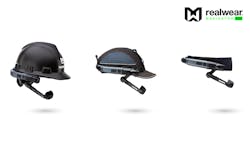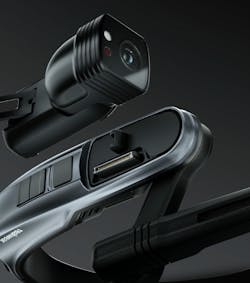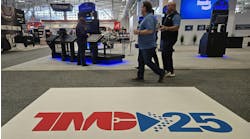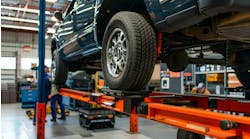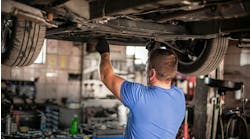Hands-on maintenance gets assist from hands-free wearable computer
In the shop of the future, the most important tool for best-in-class efficiency might be found on the technicians’ heads, not in their hands. That’s the belief of RealWear, the technology provider behind the Navigator 500 ruggedized wearable device, which is a follow-up to the Vancouver, Washington-based company’s HMT-1.
The Navigator 500 works just like a tablet, using the Android 11 operating system, and is equipped with Wi-Fi, Bluetooth, and 4G connectivity. The difference is technicians can access all visual information via a monocular display, and all the apps and features are accessed by voice command, so they never have to drop their tool to refer to complex work instructions or schematics.
And when they cannot troubleshoot a job by themselves, they can call a remote expert, who sees what they see via a 48-megapixel camera (with an LED flashlight). That expert, typically working from a laptop, can talk the tech through the job and send pictures or videos to the display. It’s like having a master technician or product engineer standing over your shoulder to ensure steps are done correctly and efficiently. These calls can run through virtual communication platforms such as Microsoft Teams, Zoom, or TeamViewer Frontline.
“The remote expert is virtually looking over your shoulder, seeing exactly what you're seeing, and you're able to describe your difficulty, and they're able to see what you're looking at and guide you through something or help correct a step that you’ve overlooked,” explained Andrew Chrostowski, chairman and CEO of RealWear.
RealWear calls their solution assisted reality, as opposed to augmented reality, because the information is the same as if it were on a tablet or laptop, but now delivered in a hands-free way that allows the technician to stay on task.
“The thesis of our assisted reality solution is providing a reality-first, digital-second experience,” Chrostowski offered. “The user is fully aware of what's working around them, they’ve got good peripheral vision, and the display appears outside of their line of sight. When they need something, like wiring diagrams, they just glance down like a pilot does with their instrument panel when they're flying. And they can remain focused on the outside world, and that will be the same experience in a truck repair bay.”
Real-world applications
In a recent pilot, MHS Truck & Bus, which distributes MAN commercial vehicles in Romania, found diagnosis time was reduced by 75%, while travel was reduced by 50%—because the distributor no longer has to send experts to the location. This method saved MHS 700 gallons of fuel per month (based on 9 experts and 80 gallons per worker). The dealer used Cisco Webex.
“MAN is embracing what we're seeing across a number of industry verticals here with assisted reality and voice-driven wearables, which is that you're able to increase uptime, shorten the time it takes you to solve a problem, and maintain your operational costs,” Chrostowski said, who spoke to Fleet Maintenance about the deployment. “It's a lower cost, higher customer satisfaction solution where every worker is able to connect and can remotely help diagnose what's going on.”
The device, which costs under $2,500 (with a discount for high volume orders), has several applications and ROI benefits, but he noted an obvious one is just the time and fuel costs saved by not sending a technician or product engineer offsite to lend their expertise.
“Many of our customers pay for their deployments in the first use,” the CEO noted due to those travel costs and the increased uptime from the vehicles being fixed faster.
“The Navigator 500 is everything that the HMT-1 one was and more because it's 30% lighter and still just as rugged,” Chrostowski noted.
Another selling point is that RealWear recognizes the pace of technology and rapid obsolescence of high-tech gadgetry.
“The first things to go obsolete are these cameras, so we built in a modular replaceable camera that can be upgraded without disrupting the actual rollout and deployment of our devices,” Chrostowski said.
The wearables have found use on everything from the tops of towering wind turbines to truck engine plants, where the step-by-step instructions provided in the headset have yielded productivity gains of 50%.
“But more importantly, because they’re working hands-free and totally immersed in their work, line workers are finding three times as many defects in the end-of-line engine inspections,” said Chrostowski, adding that the device can run for about eight hours on one battery (depending on usage), and can be hot-swapped for a fresh battery with relative ease.
The platform also allows for customized additions to aid workers in the field. By the end of the year, RealWear expects to offer an infrared camera option. And that’s perfect timing for shops, as thermal imaging is finding more applications in the commercial vehicle maintenance space.
Chrostowski, whose daughter is a regional truck driver and is always apprised of industry changes such as with electronic logging devices and 3G sunsetting, also added the connectivity is also upgradeable, with the devices holding the capacity to move from 4G to 5G.
Capturing tribal knowledge and appealing to digital natives
Because they not only stream video but can record as well, the Navigator 500 and HMT-1 can also become training aids. A maintenance department can simply get a master technician to wear one of the devices during various jobs, narrate what they are doing, and the recording can be saved to show junior technicians. This allows a company to hold onto tribal knowledge even after older technicians change roles or retire.
See also: Expanding the dimensions of technician training
And the use of this cutting-edge technology could help attract more young people to the industry, Chrostowski said. Gen Z, the group just now entering the workforce, are total digital natives, buying concert tickets or ordering food or an Uber with a few taps on their phone, he argued. If that is their personal experience, and then they come to a shop and must do everything manually with a pen and paper, “that cognitive dissonance is really jarring,” Chrostowski noted.
“And secondly, it doesn't make them feel like they're engaged in industry,” he added. “So as people are trying to attract workers, having a digital-friendly experience is going to bring people into that job area that may not otherwise be attracted to it.”
Another aspect is the ability to quickly proliferate knowledge one expert may have to the rest of the fleet. Penske Truck Leasing has found this an effective strategy to train the trainer using the Microsoft HoloLens 2, which uses a more high-tech version of augmented reality that fits over the user’s eyes and can add contextual information or images to their environment.
“AR training allows us to provide very specific skill-building events with a one-to-many approach,” said Holly Gerke, vice president of technical training and development, Penske Truck Leasing, to Fleet Maintenance. “We can give opportunities to technicians to sharpen their craft using a live instructor-led experience, and that's really very impactful.”
Chrostowski believes the use of wearables like the Navigator 500 will greatly aid in upskilling technicians as electric vehicles roll out.
“This is a perfect fit to help people and those trained technicians who are already great with the mechanical aspects of the truck and the fleet to make that transition to electric fleet maintenance,” he said.

